How to Install the PetSafe® Wall Entry Pet Door
Important Information
When you first open the box, do not throw away any included cardboard/paper pieces, these are used during install.
- Use proper safety equipment and guidelines while using any tools.
- Make sure to check for electrical and plumbing fixtures in the wall.
What Is Included:
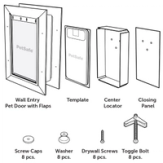
Tools You Will Need:
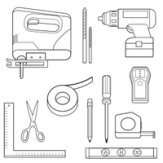
- Framing Square
- Jigsaw
- Drill
- Drill Bit: ⁵⁄₁₆ inch and ½ inch
- Philips Screwdriver
- Tape Measure
- Tape
- Pencil
- Level
- Scissors
- Stud Finder
Measure and Mark
It is important to your pet’s well-being to measure and mark your pet’s shoulder height for proper installation placement. If there are multiple pets, use the tallest pet’s shoulder height measurement.
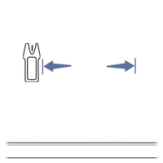
Decide where you would like to install the pet door. Use a stud finder to locate the studs in the wall and mark their location with a pencil.
Check for electrical/plumbing fixtures that could be in the wall where you wish to place the pet door.
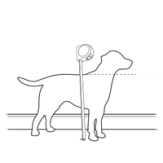
Measure and mark your pet’s shoulder height on the wall between the stud marks using either method:
- Have your pet stand next to the wall and mark their shoulder height.
- Use a measuring tape to measure your pet from the floor to their shoulder. Then apply that measurement to the wall.
Use a level to draw a horizontal line through the height marking to extend it.

Locate the center point between the two stud markings. Use a level to draw a center vertical line through the shoulder height line.
Place the Template
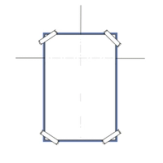
- Cut out the template along the indicated line.
- Place on your wall, aligning the height and center lines marked to the ones on the template and tape in place. The lines on the wall may need to be extended, depending on the size of the pet door.
- Use a level to confirm it is straight.
- Trace the template with a pencil, then remove from the wall.
Cut the Interior Pet Door Opening
Follow all safety instructions when using power tools. Be sure to always wear safety glasses.
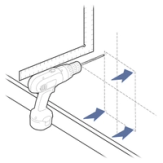
Drill holes inside each corner of the traced template using a ⁵⁄₁₆ inch drill bit. Use a framing square to hold the drill steady and straight.

Place the jigsaw blade into a corner hole and cut along the drawn template lines. Continue cutting along the template until an opening is created. Remove any insulation that is in the cutout.
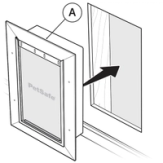
Insert the interior frame, side A, into the opening to check the fit. If the frame does not easily fit inside the opening, you may need to make adjustment cuts to the opening.
Prepare for the Exterior Frame
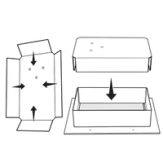
Fold the Center Locator and place it into the interior frame.
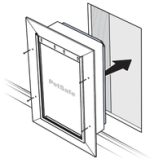
Place the interior frame with the center locator into the opening. Screw in the drywall screws to temporarily hold the frame in place.
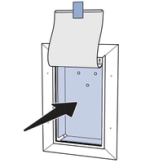
Tape the flap up and push the center locator back until it is touching the exterior wall, ensuring all the folded flaps are resting flush on the inside tunnel. Make sure the center locator is not completely pushed out of the frame.
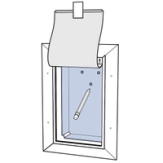
Using a pencil, mark the three center locator holes on the exterior wall. Then remove the interior frame from the wall.
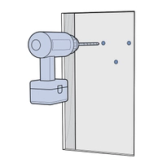
Drill out the marked holes using a ⁵⁄₁₆ inch drill bit. Be careful to keep these holes as straight as possible by holding the drill steady and straight at a 90° angle.
Cut the Exterior Pet Door Opening
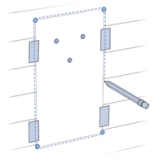
Align the template on the exterior wall with the three drilled holes. Tape in place and trace, then remove the template. Drill the four corners of the traced area using a ⁵⁄₁₆ inch drill bit.
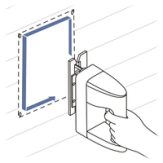
Place the jigsaw blade into a corner hole and cut along the drawn template lines. Continue cutting along the template lines until an opening is created.
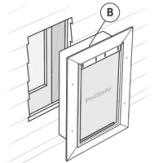
Insert the exterior frame, side B, into the opening to check the fit. If the frame does not easily fit inside the opening, you may need to make adjustment cuts to the opening.
Add Supports Within the Wall

With all frames removed from the cutout, measure the gap from the inside of outer wall to the inside of inner wall to determine the stud width needed. Then measure the width of the cutout to determine the stud length needed.
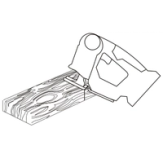
Cut a 2" x 4" or 2" x 6" piece to the width of the opening, making sure that the cut is square.
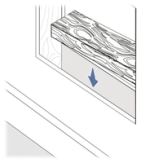
Remove any debris from the wall where the support will go. Place the piece of wood in the wall gap. Make sure the top of the wood support is flush with the bottom cutout of the wall and the support fits snugly.
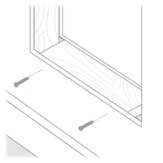
Fasten the wood support in place from the interior wall with two wood screws, making sure the support stays flush with the cutout.
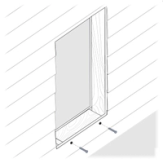
Fasten the wood support in place from the exterior with two wood screws. If placing screws into vinyl siding it may be necessary to drill a hole through the siding slightly larger than the heads of the screws. This will allow the screws to tighten flush with plywood and not buckle the vinyl siding.
Install the Pet Door Frame
If you purchased the Wall Extension Tunnel, attach it now before proceeding. For detailed instructions, visit our article How to Add Extension Tunnels to My PetSafe® Wall Entry Pet Door.
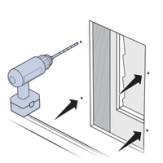
Use the holes made on the interior side as pilot holes and drill ½ inch holes.
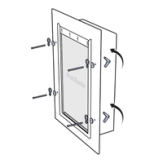
Place the screw caps and washers on the toggle screws and place through the mounting holes on the A side of the pet door. Twist on the toggle bolts onto the end of the screw, but do not tighten.
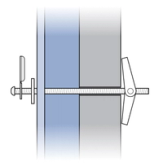
Place the A side of the pet door back into the cutout. Fold the toggle bolts and push through the ½ inch drilled holes. Ensure the toggle bolt is able to unfold on the other side of the screw hole. Then tighten all the bolts, careful not to overtighten. You may need to pull gently on the bolt to tighten the screw until the toggle is tight enough that it will hold itself in place. Close the screw cap when finished.
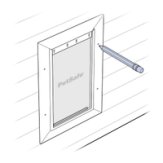
Place the B side of pet door into the exterior hole and mark the four holes for the toggle bolts.
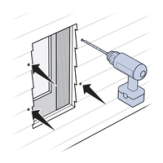
Remove the pet door and drill ½ inch holes through the marks.

Install the toggle bolts with the screw caps and washers into the B side of the pet door the same way they were installed in A side.
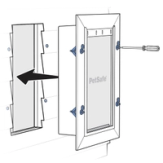
Place the B side of the pet door back into the cutout. Fold the toggle bolts and push through the ½ inch drilled holes. Ensure the toggle bolt is able to unfold on the other side of the screw hole. Then tighten all the bolts, careful not to overtighten. You may need to pull gently on the bolt to tighten the screw until the toggle is tight enough that it will hold itself in place. Close the screw cap when finished.
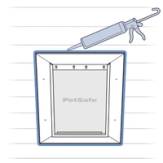
Inspect the unit for a snug fit and any gaps that could cause a draft or water penetration. Either tighten the fit or use closed cell foam and/ or silicone caulk in these areas. Use weatherproof caulk around the exterior frame and fill any gaps. If installing in a vinyl siding application, you may want to place closed cell foam and/or silicone caulk between the pet door flange and the siding.
Contact Customer Care
If you need further assistance, please contact our customer care team.